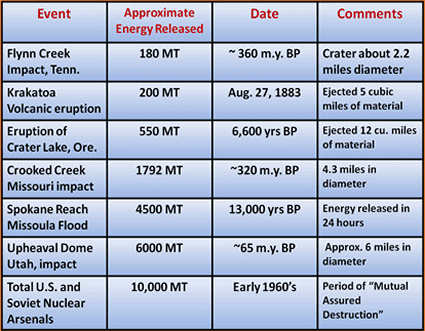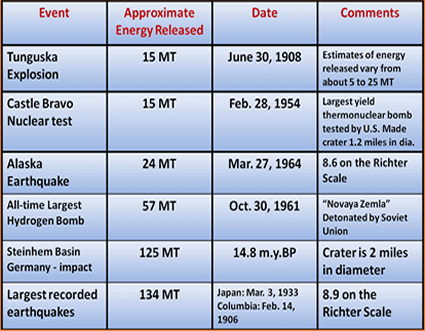Kilotons and megatons are units of measure originally created to express the energies released during the explosion of nuclear bombs. They have become a convenient way of expressing the energies released during a variety of catastrophic  events. One kiloton of energy is equivalent to that contained in 1000 metric tons of chemical high explosive, or TNT, calculated at the rate of 1000 calories per gram. One Megaton is equivalent to one million tons of TNT. A megaton is equal to 4.18 x 1015 joules. Erg is a measure or unit of work performed in the centimeter/gram/second system. It is equal to the work performed by a force of one dyne moving a mass one centimeter. A dyne is a unit of force equal to that which imparts an acceleration of one centimeter per second per second to one gram of mass. A calorie is a unit of heat energy equal to 4.1868 joules, also a unit of energy equal to the heat required to raise the temperature of one gram of water one standardized degree centigrade.
events. One kiloton of energy is equivalent to that contained in 1000 metric tons of chemical high explosive, or TNT, calculated at the rate of 1000 calories per gram. One Megaton is equivalent to one million tons of TNT. A megaton is equal to 4.18 x 1015 joules. Erg is a measure or unit of work performed in the centimeter/gram/second system. It is equal to the work performed by a force of one dyne moving a mass one centimeter. A dyne is a unit of force equal to that which imparts an acceleration of one centimeter per second per second to one gram of mass. A calorie is a unit of heat energy equal to 4.1868 joules, also a unit of energy equal to the heat required to raise the temperature of one gram of water one standardized degree centigrade.
In Cataclysms on the Columbia by John Eliot Allen and Marjorie Burns, the authors present an appendix relating the energies of the Missoula Floods to a variety of other catastrophes. They base their initial calculation of the amount energy released by dropping 380 cubic miles of sediment laden water from an elevation of 4200 feet above sea level in western Montana to 300 feet below sea level. Their calculation yields an energy release of 1.9 x 1026 ergs, equivalent to 4,500 Megatons. 4,500 megatons is roughly half of the total yield of the U.S./Soviet nuclear arsenals during the peak of the cold war in the early 1960’s. It is also equivalent to the energies released in the impact of a cosmic body on to Earth that produces a crater about 5 to 6 miles (8 km to 9.6 km) in diameter. If this cosmic body was a typical asteroid it would have a diameter of around 2000 feet.
The largest measured discharge in any flood channel of the Missoula Floods was that passing through the Spokane Valley. Measured by Victor Baker in the 1970’s the peak flow may have reached as much as 800 million cubic feet per second. In one flood there was over 500 cubic miles of water, the total volume occupying the combined Lake Missoula basins, flowing through the Spokane Valley. At the rate of 800 million cubic feet per second, if sustained for the total flood duration, the entire basin would have emptied in just over one day. In an actual flood, however, during which the entire basin of lake Missoula would drain out the Clark Fork Valley, the hydrograph would display a much more protracted, waning flow, after the initial flood surge.
The value used for Meteor Crater, Arizona could be considered the most conservative estimate as to energy released.
Mouse over thumb for larger image


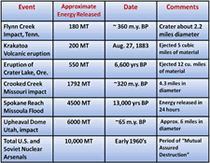

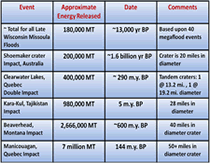
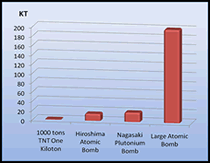
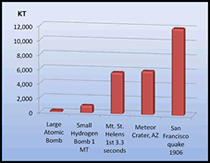
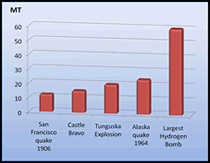


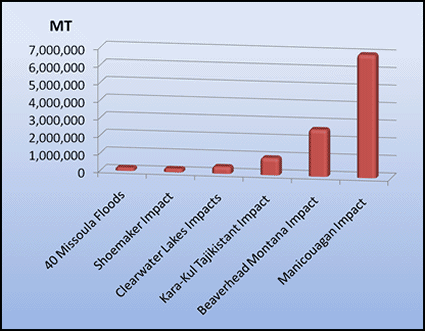 .
.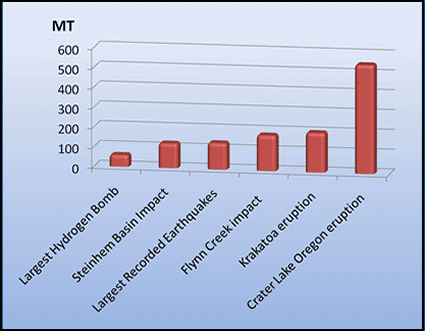 .
.
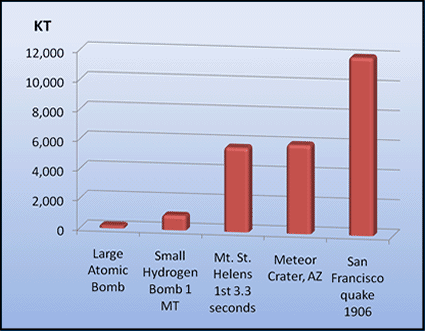

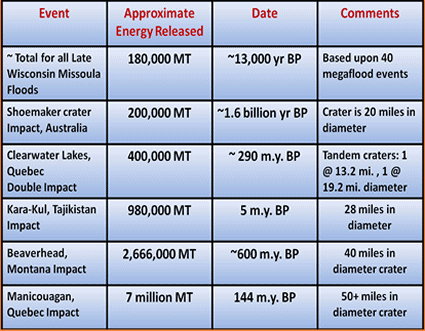 .
.
